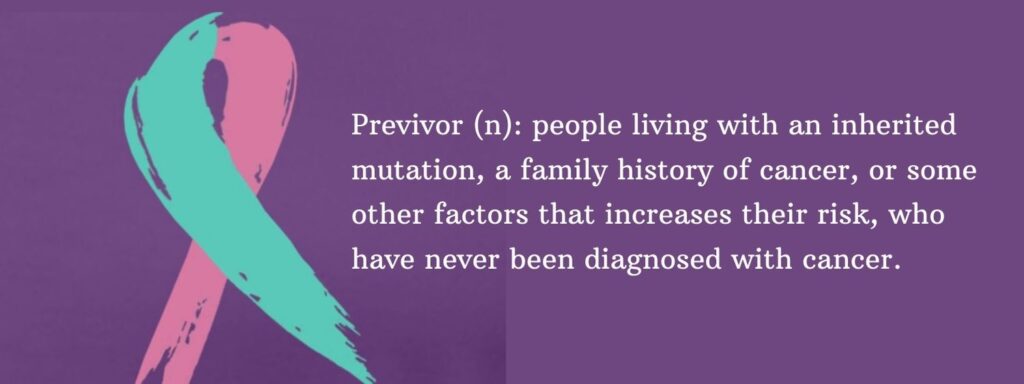
Discovering my family’s BRCA 2 mutation
In April 2023, I clutched my father’s hand in a sterile surgical waiting room, as a doctor informed us that they found a tumor in my mother’s fallopian tube. It had tested positive for ovarian cancer. During her diagnostic process, we discovered that my mother carries the BRCA 2 mutation and, thus, it was recommended that all blood relatives undergo testing as well. Six weeks later, on my 39th birthday (and two days before my mom was scheduled to begin chemo), my results arrived. I, too, carried the same mutation. At the time, I was nine months postpartum with my son and my two daughters were 7 and 5. I worked full time, my family was spread out all over the country, and my world was crumbling around me.
Life as I knew it, would never be the same
And it wasn’t. Given my age and that I had no plans to have additional children, every doctor I met with recommended a prophylactic double mastectomy and a hysterectomy/bilateral salpingo-oophorectomy (BSO). The reality that the same reproductive organs that had nurtured and brought my perfect baby boy into the world could now pose a potentially life-threatening risk was difficult to comprehend. The removal of my ovaries also meant facing certain and immediate menopause; a phase of life I had yet to even consider. After a few agonizing weeks of feeling afraid and sorry for myself, I decided to turn the negative energy into something productive.
I started by gathering information.
I met with every doctor possible: gynecologists, primary care physicians, breast oncologists, gynecologic oncologists, general oncologists, and all kinds of surgeons. I did every exam recommended: mammograms, MRIs, bone density scans, skin checks, vision checks, blood work after blood work after blood work. I connected with genetic specialists in North Carolina, hormone experts in Israel, menopause care providers in New York, and fem health leaders in Amsterdam. I admit that this sounds overboard but I took comfort in my proactiveness. I needed to feel armed with information before making any decisions about my body.
Talking with others
In time, I told my inner circle what I was up against and started accepting offers to chat with other women who had been in my position. I found that the women, often complete strangers, speaking from their own experience was more impactful than meeting with the doctors. They were able to acknowledge the pain that comes with the uncertainty of this diagnosis and laid out how they were able to make their own decisions with regard to surgery selection, timeline, and recovery management. They shared examples of how their bodies reacted to the surgeries, how they got through the emotional rollercoaster, and what their life was like now having been through it.
Nothing Pink
Somewhere along the way, I discovered NothingPink. This local organization offers support to people at high risk of hereditary breast and ovarian cancers. Among their many programs, NothingPink hosted monthly zoom support groups where we could come together to share experience and advice with women at various stages of their preventative journeys. There were many sessions where I cried the whole time or had to log out early because it all felt so overwhelming.
Eventually, the anxiety of it all was too much to bear. Every pain, bubble, or tinge that was somewhat near my abdomen had me convinced that the “silent killer” was coming for me next, so I accelerated my timeline. Six months after my mother’s diagnosis and the week of her last chemo treatment, I had my hysterectomy/BSO. Three months later, in January 2024, I had my double mastectomy, an unplanned procedure from a minor complication in February 2024, and my final exchange surgery in April 2024. Throughout each surgery, the NothingPink army was along for the ride. They provided detailed advice on what to expect before, during, and after surgery while serving as a constant reminder that I had a team of women cheering me on.
Taking control of your health
I was able to get through the surgeries knowing that I had a privilege that many others did not. I was able to choose. I could take control of my health and mitigate risks on my terms. While I knew the surgeries would be hard on me and my family, I saw firsthand how much harder it is to recover from surgery and undergo cancer treatment. I knew I had so much to live for and, when I needed a reminder, I would hug my kids, snuggle my dogs, and admire my doting husband. They needed me and they needed me healthy. Equally important, I saw it as a profound opportunity to model courage and strength for my children who might one day have to face a version of this journey as well. I wanted them to see their mommy as a fighter.
And they did.
Going back to “normal”
Today, I’m back to my “new” old self, but with a sharper focus on what truly matters and the people who are most important. I’m exercising daily, traveling the world, lifting my children high in the air, and paying it forward whenever the opportunity arises.
When I stumbled upon posts like this one – often in the middle of the night, wide awake with worry and fear – I craved advice, hope, and a dose of positivity. With that in mind, here are a few things that worked for me:
- I allowed myself to be vulnerable and connect with anyone willing to share their experience and advice. I spoke with friends of friends of friends, neighbors, coworkers, grandmothers — literally ANYONE. If they were willing to make the time for me, I made the time to listen to and learn from them. I took something away from every single conversation.
- I researched, studied, examined, and ADVOCATED. I realized that the surgeons do this day in and day out but the area specialists have unique insight and detail – be it genetics, hormones, menopause care, or risk management. I figured out what the important questions were for me to ask and made sure I always had clear answers. When they weren’t clear, I sought out other ways to get the information I needed.
- Community. The NothingPink organization and the FORCE message board offered firsthand experience and support in a way that only women who have been through it can. They were open, honest, and offered unique insight into this all-consuming shared experience. Empowered women empower women.
- Asked for help. When I was ready, I allowed myself to accept outside support. People from all walks of my life showed up in ways I never could have imagined. My neighbors organized a meal train, my friends took my kids on playdate adventures, our children’s school delivered groceries to our front porch – I was in awe. Our extended family took turns rearranging their lives to be there for us in our darkest hours, sometimes with 24 hours notice. The pain and loneliness slipped away with each and every act of kindness.
- Gratitude. Despite everything, I had so much for which to be grateful. Unlike my mother, I was in the driver’s seat. I was so afraid that my kids would be scarred for life seeing their mommy down and out but they adapted (almost too) easily. They played barbies in my bed or read books snuggled next to me. Oddly, my six year old loved helping me clear out my mastectomy drains. My husband was the ultimate teammate on this journey, the best friend I could ever ask for, and the rock of our family. I loved him more and more every single day of this experience and still can’t believe the lengths he went to to show the depth of his love for me.
- I took things one day at a time. You can only do what’s right in front of you. Some days I researched until my eyes watered from staring at my computer screen and my throat hurt from talking so much about my situation. Other days, I lost myself in work or playing with my children. I took each surgery as it came, prepped as best as I could, recovered as patiently as possible, regained my strength wherever possible, and proved to myself that if I can do this, I can do anything.
And I can.
As part of The After Cancer’s October blog series, guest blogger, Marissa Bailey shared her previvor journey and tips that can help anyone learning going through genetic testing. We were honored to be part of this blog series and to learn from other patients and organizations through their stories.
Marissa lives in Charlotte, North Carolina with her three children (Olivia, Emma, and Cameron) and her two doodles (Mila and Kaia). After years of working in media and entertainment, she is taking a professional break to focus on the next phase of her recovery: prioritizing her physical, emotional, psychological, and spiritual growth. As she starts thinking about her next chapter, however, she is confident it will involve supporting and empowering women.
